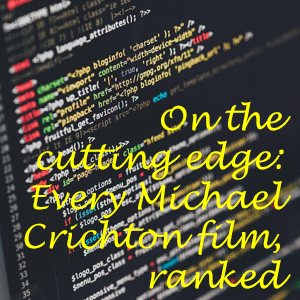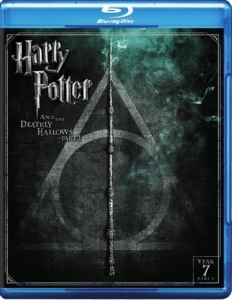“Harry Potter and the Deathly Hallows” was my least favorite of J.K. Rowling’s books because the goal-oriented plot left little room for surprises: Harry and his friends need to destroy a handful of Horcruxes — which contain pieces of Voldemort’s soul — in order to kill the baddie.
Indeed, the faithfully adapted final film chapter, “Harry Potter and the Deathly Hallows, Part 2,” suffers from roteness and professionalism. It feels like a Dementor locked its lips on the saga. The palate is gray and there’s not much music. You’ll want to chew your popcorn slowly and quietly so as not to disturb anyone from absorbing all these serious, important moments. Although they have been bumped down to cameos now, characters we liked from previous films die, and the proceedings are funereal.
“Return of the Jedi,” the finale of a similarly epic film saga, shows a happy celebration by the heroes, something that — if you think about it — is slightly off. When Voldemort (Ralph Fiennes, trying out some entertainingly creepy new facial expressions) and his followers are vanquished in “Hallows 2,” everyone sits around in somber, quiet conversation amidst the bleak ruins of Hogwarts; it’s a mix of grief and relief.
“Hallows 2” sets its bleak mood at the beginning as the camera sweeps past floating Dementors outside the fog-shrouded Hogwarts. Rather than starting with a grabber of an opening sequence, the filmmakers figure they’ve already got the audience hooked, so they give us a series of agonizingly slow and dry scenes such as Ollivander talking about wands.
On the other hand, I appreciate the fact that “Hallows 2” isn’t nearly as loaded with incomprehensible, effects-laden fight scenes as the trailers made me fear. Everything we see is shown for a reason. Some smaller details won’t make sense if you haven’t read the books — for example, why are the spiders and giants fighting on the side of the Death Eaters? — but when the camera zeroes in on a character, it’s with purpose.
The love stories, which ideally should’ve popped off the screen like never before in this final movie, lack tension. Ron (Rupert Grint) and Hermione (Emma Watson) still have chemistry; Harry (Daniel Radcliffe) and Ginny (Bonnie Wright) still don’t. The actors had an impossible task, though; so much of the story paints Harry as a solitary hero like Luke Skywalker that Harry-and-Ginny scenes never seem to fit. For that matter, the Ron-and-Hermione kiss seems like it was fulfilling a requirement, too.
Neville and Luna are cute, at least as an idea. Evanna Lynch has always been adorable as Luna and Matthew Lewis does some of his best work here as lovable underdog Neville. I’m happy that they both get a decent amount of screen time, but unfortunately it’s not as a pair; there’s only one scene of them looking couple-y.
The mystery of Snape’s (Alan Rickman) loyalty is finally revealed when Potter bottles the new headmaster’s tears and drops them into the Pensieve. What follows is the movie’s most poignant sequence, showing how Snape loved Lily Evans his whole life, even though she rejected him for James Potter. Snape’s inexplicable treatment of Harry through the years — a mixture of hatred and protectiveness — suddenly snaps into place, and considering that Snape had just died, it’s beautifully tragic.

Harry learning that he himself is a Horcrux is the other big revelation, although it seems inevitable. Harry tells Hermione he somehow “always knew,” and she doesn’t even have to be told he’s referring to having a piece of Voldemort in him: She knew, too.
Similar to the “Star Wars” saga, the Death Eaters’ goal of establishing an evil empire to oppress everyone is portrayed only through meaningful shots of students marching through Hogwarts like Nazi soldiers, and now they are all wearing drab uniforms rather than their respective house colors. As with the relationships, there’s no sense of progression here; we don’t get any juicy details of how Snape (working for Voldemort at this point) got his way, especially since he is clearly outnumbered by brave good guys such as Professor McGonagall, certainly the most kick-butt elderly woman in recent movie history.
The story’s all there, yet the lack of details makes “Hallows 2” economical and efficient rather than emotional and epic like the saga’s best entries (parts 3 and 6, for my money). We get a cool sequence in a Gringotts room where everything you touch replicates itself, something that is tailor-made for the 3-D format that all blockbusters are filmed in nowadays. And Hermione takes Polyjuice Potion and turns into Bellatrix Lestrange for a while, a callback to a funny sequence in “Hallows 1” when the trio impersonates three Ministry of Magic workers. Oh, the potential of having Helena Bonham Carter portray Hermione’s mannerisms — but it goes largely untapped.
Owing to Rowling’s made-for-a-video-game plot, “Hallows 2” is all about missions, battles and survival, and while it’s certainly not so bad that you’ll feel like a survivor just for sitting through it, it doesn’t boast the repeat-viewing value of most of the other entries. It’ll get watched many more times through the years even by casual Potterfiles like me (I’ll probably buy it on DVD as part of the full saga when it gets released), but when I do watch it, it’ll be more as a student of Rowling’s saga than as an adoring fan.
“Hallows 2” is too much business, not enough pleasure.

